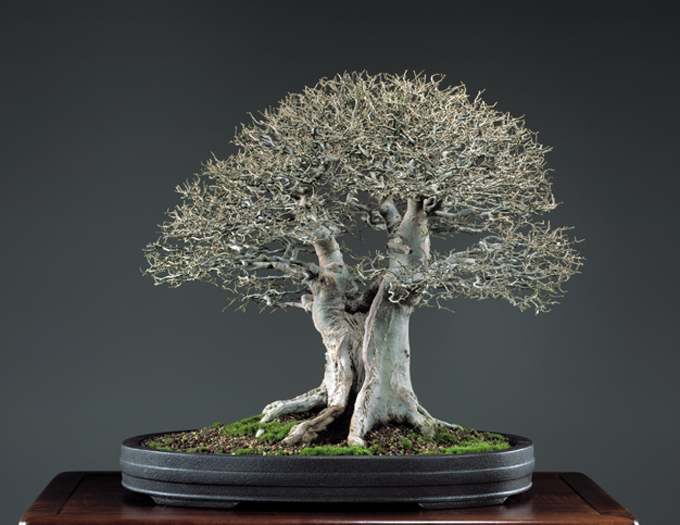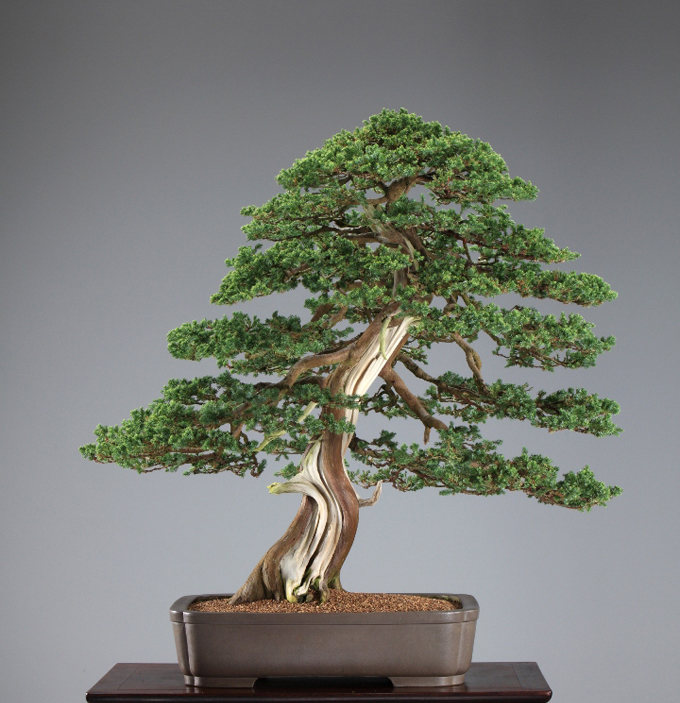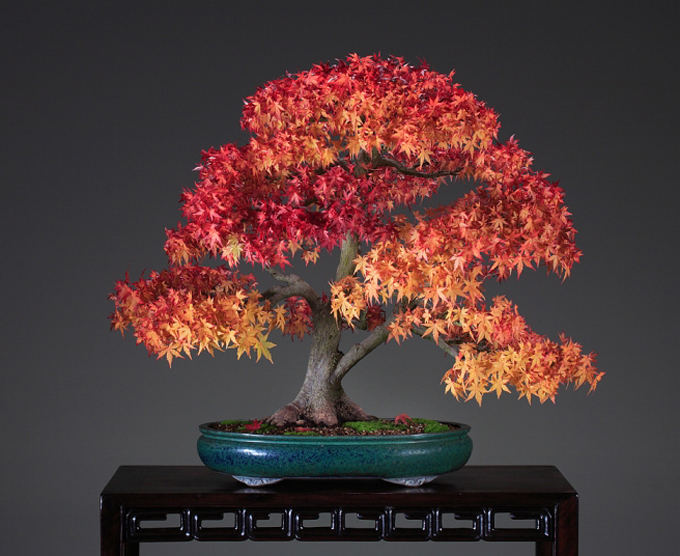 This has got to be one of the most magnificent Chinese hackberry (Celtis sinensis) bonsai anywhere. Though the distinctive split trunk needs no comment, you might also notice the highly developed ramification (fine branching). The tree was donated to the Pacific Rim Bonsai Collection by Ben Oki. We’ve featured it before, but it’s certainly worth another shot.
This has got to be one of the most magnificent Chinese hackberry (Celtis sinensis) bonsai anywhere. Though the distinctive split trunk needs no comment, you might also notice the highly developed ramification (fine branching). The tree was donated to the Pacific Rim Bonsai Collection by Ben Oki. We’ve featured it before, but it’s certainly worth another shot.
Pacific Rim. Looking for an excuse to visit the Pacific Rim Bonsai Collection? These trees might provide some incentive. Dave DeGroot, curator of the Collection, sent us the photos along with some history and some of his observations. With the exception of our last post, we’ve been featuring lots of trees from Europe and Asia lately, so it’s nice to be able to show world class bonsai that reside right her in North America.
It’s amazing what professional quality photography can do, especially when so much attention is paid to the preparation of the tree and the setting. Spectacular trees don’t hurt either. Still, a good photograph is far from seeing the real thing in person. If you’ve never visited a world-class bonsai collection and had your socks knocked off by the sheer power of trees like the ones shown here, then it’s time to mark you calender and book your trip.
 Clean flowing lines with lots of open space make for simple, elegant beauty. And there’s also the nice contrast with the deadwood and live veins. Altogether a very sweet tree. It’s a Formosan juniper (Juniperus formosana) from Taiwan (previously Formosa, thus the name). Its date of origin is 1944 and it has been a bonsai Since 1959. The artist is Mr. Kuo An Lee. Amy Liang Chang donated it to the Pacific Rim collection.
Clean flowing lines with lots of open space make for simple, elegant beauty. And there’s also the nice contrast with the deadwood and live veins. Altogether a very sweet tree. It’s a Formosan juniper (Juniperus formosana) from Taiwan (previously Formosa, thus the name). Its date of origin is 1944 and it has been a bonsai Since 1959. The artist is Mr. Kuo An Lee. Amy Liang Chang donated it to the Pacific Rim collection.
Here’s more in Dave DeGroot’s own words: “This Chinese juniper was nursery grown and trained in Taipei, Taiwan. The basic shape was created by bending the juvenile tree around a bamboo stake. Field growing enlarged the trunk, which was then topped to obtain the correct height. The illusion of great age was supported by stripping the bark from certain branches and parts of the trunk. Carved grooves and channels in the stripped trunk suggest a long period of weathering and decay, further enhancing the illusion of age and powerful natural forces.
The artist has created a feeling of gracefulness with the gently curving, slanted trunk, while the dropped branch on the right adds tension and interest by making the tree just slightly unbalanced.”
 Amy Liang Chang (you might know her as just Amy Liang) of Taiwan is the artist and donor of this gnarly old (over 400 years!) Japanese black pine (Pinus thunbergii) with its deeply grooved swirling bark that gives away it impressive age. Dave wrote this about this magnificent old tree: “The black pine is a coastal tree of southern Japan, strong, vigorous, long lived and possessed of many attractive qualities. For all the above reasons, it is known as “The King of Bonsai”.
Amy Liang Chang (you might know her as just Amy Liang) of Taiwan is the artist and donor of this gnarly old (over 400 years!) Japanese black pine (Pinus thunbergii) with its deeply grooved swirling bark that gives away it impressive age. Dave wrote this about this magnificent old tree: “The black pine is a coastal tree of southern Japan, strong, vigorous, long lived and possessed of many attractive qualities. For all the above reasons, it is known as “The King of Bonsai”.
This tree was quite tall when it was collected. In order to create a bonsai of pleasing proportions, the entire upper trunk was cut off, leaving only the lower trunk and the first four branches. Taipei bonsai artist Amy Liang Chang purchased the tree from a Japanese nurseryman in 1971 and styled into in its present form. The tree was totally cleansed of soil to permit its importation to the U.S. in 1989. Although badly stressed by that experience, it lived up to its reputation as a strong, vigorous tree and recovered fully.”
 It’s about the color. In this case, the trunk and branching, though nice, exist primarily to support and display the brilliant leaves. The speckled blue-green pot, the bright touches of moss and even the red leaves on the soil all serve to enhance this delightfully luminous display. It’s a Japanese Maple (Acer palmatum – I just noticed that we don’t have the name of the cultivar and it’s too late to ask, so we’ll offer a ten dollar gift certificate to the first person who writes the correct name in the comments below). The artist and donor was George Gray of Dallas, Texas. It’s date of origin is 1963 and it has been a bonsai since 1968.
It’s about the color. In this case, the trunk and branching, though nice, exist primarily to support and display the brilliant leaves. The speckled blue-green pot, the bright touches of moss and even the red leaves on the soil all serve to enhance this delightfully luminous display. It’s a Japanese Maple (Acer palmatum – I just noticed that we don’t have the name of the cultivar and it’s too late to ask, so we’ll offer a ten dollar gift certificate to the first person who writes the correct name in the comments below). The artist and donor was George Gray of Dallas, Texas. It’s date of origin is 1963 and it has been a bonsai since 1968.
Here’s what Dave DeGroot wrote about this colorful tree: “Certainly, the Japanese maple is one of the most beautiful trees in any landscape, and one of the most beautiful for bonsai as well. Artist George Gray developed this maple from a cutting over a period of more than 30 years. Such a long time in a shallow pot has given the tree excellent surface roots and delicate, well-proportioned branches, so that it projects a sense of both strength and softness. A low, upswept branch on the right side of the tree adds interest by suggesting a secondary trunk.
The shape of the Tokoname-ware container is oval to harmonize with the softly rounded shape of the crown of the tree. The beautiful blue-green color of the container is a perfect foil for orange and red autumn foliage.”
Related books that might interest you
Our Masters’ Series Juniper Bonsai book.
Our Masters’ Series Pine Bonsai book.
Amy Liang’s The Living Art of Bonsai.
Bonsai with Japanese Maples by Peter Adams.
Great pictures and article .
‘Shigitatsu-sawa’?
How about Shin Deshojo?
This juniper shows that if you know what you are doing, field grown stock can have the ” wow ” factor like a yamadori. I wonder if there will be a trend where people start going to Taiwan and China to study instead of the traditional Japan?
I look forward to meeting and learning from Dave Degroot at the 2013 Golden State Bonsai Federaratiom convention in Burbank, California Holloween weekend.
Stone lantern rocks! ( some pun intended).
Anyone else think that formosan juniper looks like one of the tree people from lord of the rings. the live veins look like legs, and those first two branches look like arms
I noticed that too…lol
These are very nice trees though. Great post! Amy Liang’s book is one of my favorites too!
This Dwarf Maple is a Select Seedling,
not a named cultivar.
Hi Elliot,
Interesting observations. I think you are on to something about the potential of field grown stock, though there are some limits when compared to yamadori (material from the wild for our newbies).
Thanks for the kind words and the somewhat intended pun.
Aha. Lord of the Rings lives on!